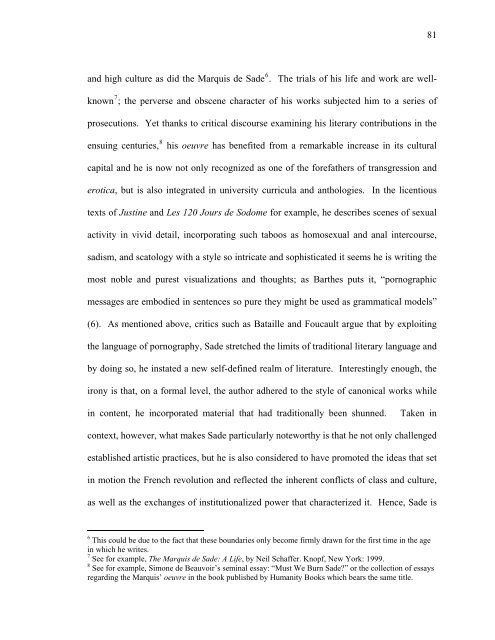Untitled - Sexey's School Moodle
Untitled - Sexey's School Moodle
Untitled - Sexey's School Moodle
Create successful ePaper yourself
Turn your PDF publications into a flip-book with our unique Google optimized e-Paper software.
and high culture as did the Marquis de Sade 6 . The trials of his life and work are well-<br />
known 7 ; the perverse and obscene character of his works subjected him to a series of<br />
prosecutions. Yet thanks to critical discourse examining his literary contributions in the<br />
ensuing centuries, 8 his oeuvre has benefited from a remarkable increase in its cultural<br />
capital and he is now not only recognized as one of the forefathers of transgression and<br />
erotica, but is also integrated in university curricula and anthologies. In the licentious<br />
texts of Justine and Les 120 Jours de Sodome for example, he describes scenes of sexual<br />
activity in vivid detail, incorporating such taboos as homosexual and anal intercourse,<br />
sadism, and scatology with a style so intricate and sophisticated it seems he is writing the<br />
most noble and purest visualizations and thoughts; as Barthes puts it, “pornographic<br />
messages are embodied in sentences so pure they might be used as grammatical models”<br />
(6). As mentioned above, critics such as Bataille and Foucault argue that by exploiting<br />
the language of pornography, Sade stretched the limits of traditional literary language and<br />
by doing so, he instated a new self-defined realm of literature. Interestingly enough, the<br />
irony is that, on a formal level, the author adhered to the style of canonical works while<br />
in content, he incorporated material that had traditionally been shunned. Taken in<br />
context, however, what makes Sade particularly noteworthy is that he not only challenged<br />
established artistic practices, but he is also considered to have promoted the ideas that set<br />
in motion the French revolution and reflected the inherent conflicts of class and culture,<br />
as well as the exchanges of institutionalized power that characterized it. Hence, Sade is<br />
6<br />
This could be due to the fact that these boundaries only become firmly drawn for the first time in the age<br />
in which he writes.<br />
7<br />
See for example, The Marquis de Sade: A Life, by Neil Schaffer. Knopf, New York: 1999.<br />
8<br />
See for example, Simone de Beauvoir’s seminal essay: “Must We Burn Sade?” or the collection of essays<br />
regarding the Marquis’ oeuvre in the book published by Humanity Books which bears the same title.<br />
81



